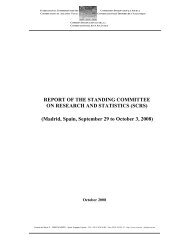E - Iccat
E - Iccat
E - Iccat
You also want an ePaper? Increase the reach of your titles
YUMPU automatically turns print PDFs into web optimized ePapers that Google loves.
PANEL 2<br />
There has not yet been enough time to detect with confidence the population response to the measures<br />
implemented under the latest western bluefin rebuilding plan [Rec. 10-03]. Nevertheless, the available fishery<br />
indicators as well as the current assessment suggest the SSB of western Atlantic bluefin tuna continue to<br />
increase.<br />
Despite the uncertainty regarding the long-term productivity of the stock under either recruitment scenario,<br />
current catches (1,750 t) should allow the biomass to continue to increase. Larger catches in excess of 2,000 t<br />
will prevent the possibility of the 2003 year-class elevating the productivity potential of the stock in the future.<br />
Maintaining the catch at current levels is expected to allow the spawning biomass to increase, which may help<br />
resolve the issue of low and high recruitment potential. For example, should the high recruitment hypothesis be<br />
correct, allowing substantial increases in spawning biomass should lead to higher recruitment.<br />
5.2.3 Other matters<br />
The SCRS Chair elaborated on the creation and history of the ICCAT Atlantic-wide Research Programme for<br />
Bluefin Tuna (GBYP). The ICCAT-GBYP started in March 2010 and its main research activities focused on<br />
improving basic data collection, better understanding of key biological and ecological processes, improving<br />
assessment models and provision of scientific advice, with special attention to the development of fishery<br />
independent indicators.<br />
The Chair then presented more details on specific GBYP projects. Phase 1 of the GBYP was the revision of the<br />
tagging design and tagging manual. In Phase 2, 3600 tunas were tagged, and during Phase 3 (in progress) 4600<br />
tunas were tagged providing direct estimates of fishing mortality, natural mortality, mixing and abundance. For<br />
Phase 4 (2013) of the GBYP, there is a critical need to establish multi-year funding to avoid annual uncertainty<br />
in cash flow. The current system of annual funding limits what can be achieved in the field and introduces<br />
potential inefficiencies in the use of funds. It was stressed that the establishment of a Scientific Quota would be<br />
extremely important for stability and the efficiency of the Programme and that all concerned CPCs need to<br />
provide the financial support that will allow the GBYP to support the ICCAT Secretariat initiatives concerning<br />
GBYP activities in their territorial waters and/or airspace.<br />
Under the GBYP, the SCRS has been able to conduct aerial surveys of spawning aggregations of bluefin tuna in<br />
order to provide indices of spawning stock abundance. These surveys must be conducted for several years to<br />
have a minimum number of years to get reliable indices. The SCRS recommended the extension of the surveyed<br />
area in 2012 and indicated that without a sufficient number of years of adequate financial support and the<br />
guarantee of flight permits, these surveys would not provide reliable results.<br />
Data recovery under the GBYP resulted in the acquisition of data on 23,000,000 tunas (740,000 t) from 118,000<br />
fishing operations. This constitutes a considerable improvement in the data available for scientific use. The trap<br />
database also now includes records from the XVI century.<br />
Projects involving biological and genetic sampling and consequent analyses were awarded to a Consortium of 14<br />
Institutes from 11 countries. The Consortium is collecting very valuable samples and some preliminary analysis<br />
show very promising results. The priority for the next phase will be the analysis of the collected samples together<br />
with the necessary continuation of sampling.<br />
The Chair then addressed the SCRS responses to the following Commission’s requests:<br />
− To advise the Commission on the creation of sanctuaries for bluefin tuna [Rec. 10-04, paragraph 26] (see<br />
Item 18.1 of the 2012 SCRS Report).<br />
In 2010, the SCRS gave advice to the Commission on the location and timing of bluefin spawning in the<br />
Mediterranean. New information was available in 2012. The current knowledge indicates that bluefin tuna<br />
spawning locations are probably wider than assumed in the past and could cover more than half of the<br />
Mediterranean Sea surface (mostly in the southern part). Furthermore, the locations and timing of bluefin tuna<br />
spawning is likely to vary substantially from year-to-year. Consequently, the implementation of sanctuary areas<br />
aimed at protecting bluefin spawning should be large enough to be effective at the population level and would<br />
necessitate an integrative approach to evaluate the optimal design in terms of size, location(s) and time/season.<br />
− To advise the Commission on the identification of spawning areas for western Atlantic bluefin tuna [Rec. 10-<br />
03, paragraph 20] (see 18.1 of the 2012 SCRS Report).<br />
239

















